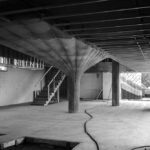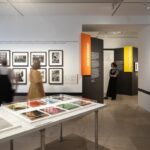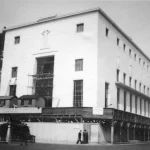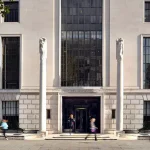Princeton University Art Museum Architecture Event, Gothic Revival USA show in New Jersey
Princeton University Art Museum : Gothic Revival Exhibition
Princeton University Art Museum Event, New Jersey, USA
Nov 17, 2011
Princeton Art and Design Are Highlighted at the Princeton University Art Museum in ‘Princeton and the Gothic Revival : 1870–1930’
25 Feb – 24 Jun 2012
Forty Works Examine the Language of Medieval Forms February 25–June 24, 2012
Princeton University Art Museum Exhibition – Gothic Revival
PRINCETON, NJ – When Princeton University—then still known as the College of New Jersey—sought to modernize itself as a progressive institution of international stature, it did so in part by adopting a visual language drawn from the past: the Gothic vocabulary of the “ancient universities” of Oxford and Cambridge. Princeton and the Gothic Revival: 1870–1930 explores the Gothic Revival movement in architecture and design across America at the end of the nineteenth century, using Princeton’s campus as a case study and launching point.
This exhibition draws from the Art Museum’s unique resources, as well as those of Princeton’s Firestone Library and the University archives, along with the Metropolitan Museum of Art and other institutions, to suggest the central role Princeton played in the Gothic Revival movement, its motivations, and its meanings in defining a great modern university. Princeton and the Gothic Revival: 1870–1930, which comprises forty works of art––many never before exhibited or published––is on view at the Museum from February 25 through June 24, 2012.
Cram and Ferguson, architects, Boston, fl. 1915-1941: Proposed exterior of chapel (S41). Watercolor on wove paper, approximately 96.5 x 71.1 cm. University Archives, Department of Rare Books and Special Collections, Princeton University Library:
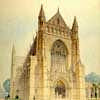
image Courtesy the University Archives, Department of Rare Books and Special Collections, Princeton University Library
“Ultimately, Princeton and the Gothic Revival examines how the language of medieval forms was used to articulate a new model of American higher education, both in campus design and in the classroom,” said Johanna G. Seasonwein, the Museum’s Andrew W. Mellon Curatorial Fellow for Academic Programs, who organized the exhibition. “Our goal is to give Museum and campus visitors an opportunity to understand how Princeton employed Gothic Revival architecture to create a new identity for American higher education during an era that also saw a growing interest in the study of medieval art and architecture, both internationally and at the University itself.”
According to Museum Director James Steward, “Our goal is fundamentally to understand the meaning of this extraordinary Gothic Revival language for the University’s very identity as one of the nation’s oldest universities, which was in the process of remaking itself into one of the world’s best.”
Gothic Revival at Princeton multimedia tour
In conjunction with the exhibition, a mobile website will be available for visitors to access from their own smartphones. Through the site, visitors to campus will experience the development of the Gothic Revival at Princeton via a multimedia tour of the campus, including many of its most beautiful and beloved buildings. As an extension of the current ongoing collaboration between the Museum and the Princeton Libraries and Archives, the Princeton and the Gothic Revival website will highlight existing and historic sites presented in the exhibition, drawing on images of historic buildings from the University Archives, as well as from personal reminiscences and expert voices recorded for the tour.
“As our first mobile site, the Museum is delighted to extend the exhibition in our galleries into an interactive experience of the heart of Princeton’s historic campus,” said Steward. “Through the mobile tour site, users will be able to access rich content that includes historic images, textual and audio narratives, and comparative images with other works from the American Gothic Revival movement in art and architecture so they can explore our campus in wholly new ways.”
Alexander Jackson Davis, American, 1803–1892: Glen Ellen: perspective, elevation, plan, 1832–33. Watercolor, ink and graphite on paper, 55.2 x 39.7 cm. The Metropolitan Museum of Art, Harris Brisbane Dick Fund, 1924 (24.66.17):
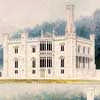
image © The Metropolitan Museum of Art / Art Resource, NY
Princeton and the Gothic Revival: 1870–1930
Princeton and the Gothic Revival: 1870–1930 is organized into four sections:
– The American Gothic Revival before 1870 introduces the American interpretation of the Gothic Revival movement, which began in England in the mid-eighteenth century but did not become popular in the United States until the mid-nineteenth century.
– The Gothic Revival in the Gilded Age focuses on the eclectic approach to the art and style of the Middle Ages during the 1870s and 1880s, when wealthy patrons donated funds for the construction of lavish buildings at Princeton.
– The Middle Ages and the Modern University investigates the concurrent development of the new discipline of art history, the collecting of authentic works of medieval art for new art history departments and museums, and the use of medieval-style buildings on campus—and the reflection in these new buildings of the growing interest in scientific, object-based study.
– The Collegiate Gothic Campus makes a connection through the English Collegiate Gothic idiom between the new American university and the earlier English colleges of Oxford and Cambridge, institutions that the new Princeton University sought to emulate, in terms of both architecture and pedagogy.
Princeton and the Gothic Revival is accompanied by a fully illustrated catalogue published by the Princeton University Art Museum and distributed by Princeton University Press. The catalogue features three essays written by Seasonwein and an illustrated checklist of the exhibition. The first essay, “Spires and Gargoyles,” introduces the main themes of the exhibition, while the second, “Princeton and the Changing Face of Gothic,” places Princeton’s architecture within the larger context of developments in Gothic Revival style. The third essay, “‘That Ancient and Most Imperishable of the Arts’: The Role of Stained Glass in the Development of the Gothic Revival at Princeton,” considers the changing approach to the idea of “Gothic” through a case study of three buildings and their stained-glass windows: Marquand Chapel, Procter Hall at the Graduate College, and the University Chapel.
Princeton and the Gothic Revival: 1870–1930 has been made possible by generous support of Christopher E. Olofson, Class of 1992; the Kathleen C. Sherrerd Program Fund for American Art; the Allen R. Adler, Class of 1967, Exhibitions Fund; and Exxon-Mobil Corporation. Support for the publication has been made possible by the Andrew W. Mellon Foundation and the Barr Ferree Foundation Fund for Publications, Princeton University. Additional funding has been provided by the Partners and Friends of the Princeton University Art Museum.
Princeton University Art Museum
Founded in 1882, the Princeton University Art Museum is one of the nation’s leading art museums. Its collections feature more than 72,000 works of art ranging from ancient to contemporary, and concentrating geographically on the Mediterranean regions, Western Europe, Asia, and the Americas. The Museum’s collections are particularly strong in Chinese painting and calligraphy, art of the ancient Americas, and pictorial photography.
Committed to advancing Princeton’s teaching and research missions, the Art Museum serves as a gateway to the University for visitors from around the world. The Museum is intimate in scale yet expansive in scope, offering a respite from the rush of daily life, a revitalizing experience of extraordinary works of art, and an opportunity to delve deeply into the study of art and culture.
The Princeton University Art Museum is located at the heart of the Princeton campus, a short walk from the shops and restaurants of Nassau Street. Admission is free. Museum hours are Tuesday, Wednesday, Friday, and Saturday, 10 a.m. to 5 p.m.; Thursday, 10 a.m. to 10 p.m.; and Sunday, 1 to 5 p.m. Free highlight tours of the collections are given every Saturday and Sunday at 2 p.m. The Museum is closed Mondays and major holidays. For information, call (609) 258-3788 or visit the Museum’s website at http://artmuseum.princeton.edu/.
Princeton University Art Museum
Princeton University
Princeton, NJ 08544-1018
Location: Princeton University, New Jersey, United States of America
Princeton University Buildings
Frick Chemistry Laboratory – Princeton University Building
Hopkins Architects with Payette Associates
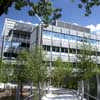
photo : Princeton University, Office of Communications, Denise Applewhite
Princeton University Laboratory Building
Princeton University – Arts Buildings
Design: Steven Holl Architects
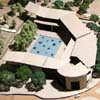
image : Princeton University
Princeton University Building
16-18 Quarry Street – housing, Princeton Borough
RMJM Hillier
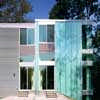
photo from architects
Princeton House
University Medical Center Princeton Hospital
RMJM Hillier / HOK
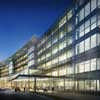
photo from architects
Princeton Hospital
Princeton University – Chemistry Building
Hopkins Architects
Princeton University – Genomics building
Rafael Vinoly
Princeton University – Science Library
Frank Gehry
Princeton University – Whitman College
Porphyrios Associates
Approx. $136m dormitory building
American Architecture Events
US Architectural Events – Selection
Center for Architecture in New York Events
PSU Department of Architecture Events
UB School of Architecture Events
Columbia University Architecture Event
SCI-Arc Architecture Events, Los Angeles
Architecture and the City Festival San Francisco
Comments / photos for the Princeton University Art Museum Architecture Events page welcome
Website: http://artmuseum.princeton.edu/

